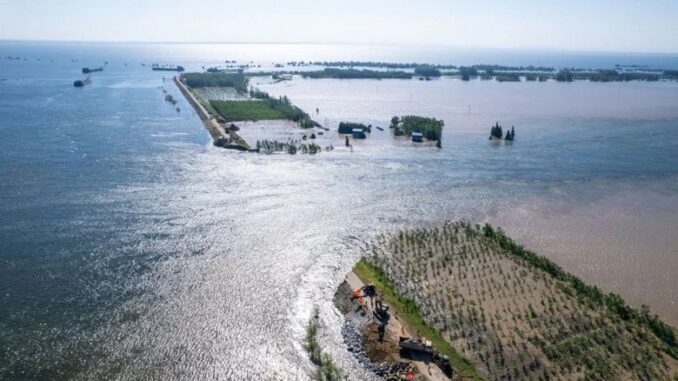
Urgent Calls for Localized Climate Risk Adaptation Solutions in China: Greenpeace.
Greenpeace East Asia’s Beijing office on July 19, 2024 issued a call, in the light of experience in responding to major climate change-induced flood events, for China to develop a greater emphasis on local strategies for disaster prevention. The Greenpeace statement follows:
Since April 2024, southern regions of China have experienced long-lasting heavy rainfall events, leading to multiple floods in 21 provinces or municipalities. According to official statistics, heavy rain, floods, and consequential geological disasters affected 14.34 million person-times, causing 230 deaths or missing persons nationwide in the first half of the year. The breach at Dongting Lake in Yueyang, central China’s Hunan Province, has also sparked public concern about flood control amid climate change. The 226-meter gap dike breach developed within one day due to the “piping effect”, over 7600 local residents were evacuated. This event has sparked numerous discussions online about EWE-induced disaster response.
According to meteorologists in the National Climate Center, the large-scale and prolonged intensive rainfalls can be attributed to the Western Pacific subtropical high channeling abundant moisture in the southwestern seas. Their projection shows that China is likely to experience more extreme precipitation events. Over the next 30 years, the maximum consecutive five-day precipitation shows a consistent increasing trend nationwide, with a rise of over 10% expected in the northwestern regions, eastern regions, and the Yellow River Basin.
The increasing abruptness, extremity, duration, and frequency of extreme weather events accompanying climate change, have raised the probability of local disasters across all river basins nationwide, escalating flood prevention challenges.
Due to China’s vast territory and diverse climate types, spatial and temporal distributions of water resources across different regions vary significantly. Throughout history, China has faced a multitude of droughts and floods. Such incidents are likely to become more common due to climate change. Managing floods in small and medium-sized river basins has long been a formidable task because of the frequent short-duration, high-intensity floods. The multitude of small-scale water conservancy projects located sparsely across the country imposes a significant maintenance challenge, and it indicates a reduced sufficiency in resisting future flood risks, especially for remote reservoirs and hydraulic facilities.
Faced with imminent climate risks, the Ministry of Ecology and Environment released the latest version of The National Climate Change Adaptation Strategy 2035. It underscores the concept of “proactive response” to climate change impacts and particularly emphasizes the goals of establishing an early warning system and enhancing monitoring and alert capabilities.
However, observations from the flood season of 2024 indicated that across regions, infrastructure needs to be improved to deal with intensifying extreme events. While enhancing emergency response capabilities, it is also essential to proactively identify the deficiencies inherent in existing infrastructure before extreme weather events occur.
Moreover, localized strategies and solutions still need to be designed and implemented to address the specific risks of each locality and effectively enhance climate risk adaptation capabilities. Due to limited prior exposure to droughts or floods, some local governments and residents need more experience, awareness, and responsive measures for disaster prevention. Therefore, a local understanding of climate risk is necessary, otherwise, the government-led top-down strategies would be difficult to comprehend, let alone be implemented locally.
Given the complexity of climate risks, mutual assistance within local communities and individual self-rescue actions are also vital to increase climate resilience, aside from national-level policies. As we navigate the uncertain terrain of climate change, embracing localized adaptation strategies at all levels remains imperative for a prepared tomorrow.
ENDS
Source: Greenpeace East Asia – Beijing, July 19, 2024. https://www.greenpeace.org/eastasia/blog/8602/urgent-calls-for-localized-climate-risk-adaptation-solutions-in-china/